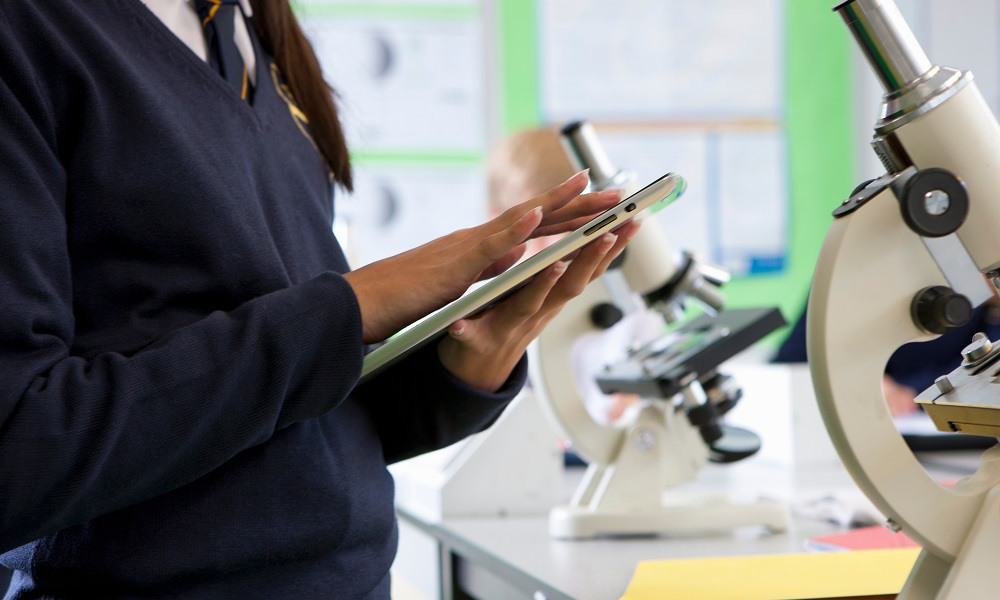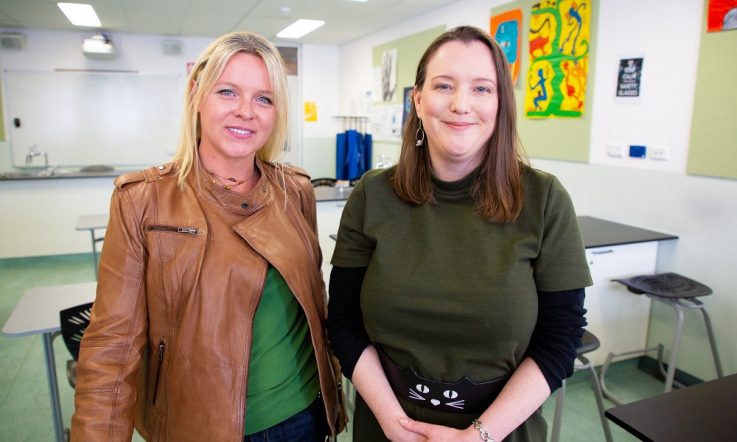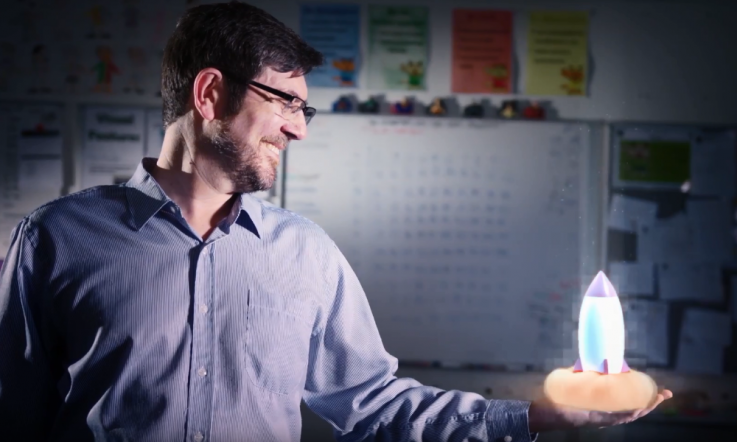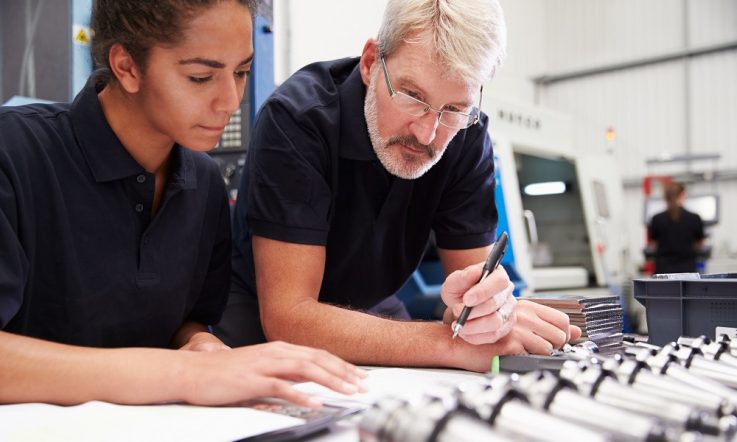This podcast from Teacher is supported by the University of Melbourne's Graduate School of Education. Study at a university that recognises the unique ability of educators to impact future generations.
Hello, and thanks for downloading this podcast from Teacher magazine. I'm Dominique Russell.
In this special episode, I'm delighted to be joined by the two recipients of this year's Prime Minister's Prizes for Excellence in Science teaching. Sarah Finney, a Grade 3 and 4 classroom teacher at Stirling East Primary School in South Australia was named winner for primary school teaching, and Dr Samantha Moyle from Brighton Secondary School, also in South Australia, was named winner for secondary teaching. Both educators are remarkably dedicated to harnessing curiosity about Science in their students, and providing them with authentic, real-world learning experiences. We'll hear from Samantha Moyle later on in this episode, but first, we'll speak to Sarah Finney about her approach to Science teaching. Let's jump in.
Sarah Finney: I believe that children are born scientists and that it's my job to harness their curiosity and help them to understand Science through engaging in, or experimenting and engaging in, their own interests.
So I begin with what they love to do and I start on their own interests. I tell stories also of scientists who've made mistakes, whose mistakes have become important to mankind. And I use this to encourage a growth mindset, which is the idea that it's okay to make mistakes and this is how we learn.
Dominique Russell: And so I'm sure as well the huge Science inquiry unit that you've developed, it's such a big part of that. So for our listeners, could you explain what exactly this is and why you implemented it?
SF: Sure. So I've been interested in students following their own investigations for some time now, because the research shows that students maintain more information if they learn through the inquiry method. It all came about because our group of Year 3 and 4 teachers were put together for the first time and, you know, we knew that often the early years and the senior years are celebrated in schools and the middle years kind of sometimes miss out a little bit.
So my PLC [Professional Learning Community] was interested in establishing a middle year's identity. And when I suggested I lead the students through the scientific inquiry process, my colleagues hopped on board and they understood that Science is my passion and it kind of sprang from there.
I begin by asking students about their interests, which is an excellent way to begin the year, so I do it at the start of the school year. And I encourage them to ask questions about whatever it is that they've identified as their interest. Then I give them an explicit lesson about what makes a scientific question. And we review their lists to see if any of the questions that they've written are scientific questions, or whether they can adapt them to become scientific questions.
Then I teach about variables and what a variable is, and all the different types of variables. And we do this through something from the Primary Connections units of work; which they suggest to use a dress-up race. And you step the children through that procedure and they quickly learn what a variable is and why it's important that everything has to be kept the same except for the independent variable that you change.
So following on from that, I step the children through a simple experiment to familiarise them with the different parts of the scientific method and so that we can practice talking about variables. And once they've got their own scientific question, they gather their data in their own time. So I rely a lot on goodwill of parents, I guess, to help them gather data. So, parents might be timing how quickly their bikes go on different surfaces, or the parents might be involved in taking them to the park so they can bowl cricket balls versus tennis balls to see the difference in spin, or whatever it is that they're investigating. They gather their data and they bring it back to school where I teach them explicitly how to represent and interpret their data.
We're lucky because we've got 1:1 iPads, so we use Google sheets there. But following this data analysis they learn how to write conclusions and then we share our work with real scientists who I invite to offer feedback on their learning. And the children find it very exciting, especially when the process is repeated for them when they're in Year 4 and they can see huge growth in their understanding and in their successes.
DR: You mentioned just there it's a great way to start the year off. How long does this inquiry unit bring you to? Where does it finish in the year?
SF: So the inquiry unit finishes at a really good time, actually. Just in time for the children to enter the Oliphant Science Awards with their inquiries, which is roughly halfway through the year.
It's a really long process because generally it takes a long time for the children to identify what it is that they want to investigate. So we're talking, six weeks or so there. It's lengthy, but I really do think the children grow and learn from it and are excited by the results.
DR: And so something that I'm really excited to talk about now is how you mentioned that your school really brings together old and new technologies. So could you explain what that means?
SF: I co-begun a primary science teachers of South Australia professional learning community that runs in the southern suburbs of South Australia with a few other teachers and we lend resources to each other and share ideas to engage the students – I find that really useful.
One of the things that came from that was one of ideas for National Science Week, that you could open up an Oreo cookie and scrape away at the cream to make a picture of various stages of the moon, because the moon was the focus of National Science Week. And so I took that idea and got my children to do it, but because we have our iPads, I said ‘well we can now make stop motion animation of the whole experience and just add to it and make it more alive for the children'. So that's one thing that we can do.
We've also engaged in a ‘design a Zoo enclosure' activity after we visited the Adelaide Zoo. We used an app called co-spaces which has a virtual reality component and the students made choices about what to and how to build their enclosure based on animal needs, keeper needs and public needs. They were also able to record a virtual tour of the enclosure and as the viewer walked around the tour they could hear the children explain all of their scientific decisions.
One other thing that I've modified is something that I got when I went to the National Science Teachers Association Convention in Darwin this year, and I went to a workshop all about National Science Week and there was an activity using Freddo frogs. Which I thought ‘excellent, my students will love that, it's based on chocolate'. And the task was that children were to design a heat shield for their Freddo frogs because it was supposed to emulate the fact that astronaut suits have to experience huge differentials of temperature, but also because the command module of the Saturn V needed a heat shield for re-entry.
So they took that task, but because we had the iPads the students could video the task and they have made– I've added other parts to it, so the children watched the ABC special on the moon landing, that has Julia Zemiro and Brian Cox in it and they looked at how students training to be astronauts have to undergo tasks using altered sensory perception. And so I asked the children to design some altered sensory perception environments where they could open a Freddo frog. So they had the opening the Freddo frog, they had the melting the Freddo frog, but then we used bi-carb soda and vinegar rockets and we'd strapped Freddo frogs to them and the children have tested what rocket fuel is best – whether a Alka-Seltzer tablet or whether bi-card soda paste is better to combine with vinegar to shoot them up in the air. They're recording video of this and they're making a narrative of the ‘frog-straunat's' whole space experience which just adds a whole different experience to their learning because they're able to articulate a lot better what's happening, orally, and to tell that story orally is, for a lot of students, much better than writing it all down in a standard scientific report which they've already learnt how to master in Term 1 and Term 2 through their inquiry projects.
… And a lot of my learning has come from the STEM X program. I would very much, very strongly state that it's been my best ever professional development and probably will be my best ever professional development I've ever attended. It runs for five days in Canberra in the January holidays. And it is competitive entry, but it's run in conjunction with CSIRO [Commonwealth Scientific and Industrial Research Organisation], ANU [Australian National University], Questacon and the Australian Science Teachers' Association. So the training that you get is top class.
What's also fantastic about it is they take 35 primary and 35 secondary teachers. It's a close group. And then following on from the whole experience, there's a Facebook page which has been, like, lifeblood. Every day I check it and chat with people and it's a great resource to put out there – ‘I'm going to do this, what advice have you got?' or ‘where can I get this information from?' – Because you know that some of the best teachers in Australia are there who can help you easily.
One great thing that came from it was while we were at the STEM X program, we visited Mt Stromlo observatory and astrophysicist, Dr Brad Tucker, was there. Some people might know him from Sunrise [a morning news television program in Australia], he's often on Sunrise talking about new space exploration and space news. So he took us through a talk and following that I invited him to come to our school. He visited quite a few of the STEM X people's schools and he brought with him PhD students.
One of the things we did at Questacon was we learned how to do a Rube Goldberg Machine with a whole class of children. And for those of you who don't know, the Rube Goldberg Machine is kind of a perpetual motion, domino express, marble run, gone wild. But we did that, I devoted a whole week to that at the end of the term. The children had to earn money to buy components of it. And when I say money I mean virtual money. There's actually a website where you can give children virtual money and there's a whole Mathematics program that goes with it. And it's called Banqer, for those of you out there, it's free. I don't know who I'm promoting there, but it's free and so children earnt ‘Banqer bucks' for doing the right things in the classroom and spent them on components of this Rube Goldberg Machine.
Brad Tucker visited the school and his two physics PhD students came to help my children to solve some of their problems with their Rube Goldberg Machine. But, not only that, he spoke to the senior part of the school and then he gave a star gazing night to the local community for free, and he also bought two telescopes which he left at my school which we're hoping to get out next week to do another star gazing evening.
This STEM X program has just led to unimaginable doors being opened and it's something that, if you are a science teacher and you're passionate about science teaching and you want to get better and you want to share your love for science, you should really consider applying for.
Coming up, we speak to Dr Samantha Moyle from Brighton Secondary School about how she's improving Science education at her school. But first, here's a message from our sponsor.
You're listening to a podcast from Teacher magazine, supported by the University of Melbourne's Graduate School of Education. Whether you are looking to transform your classroom or influence education policy, our education courses for professionals will open your mind to the latest thinking and give you practical skills to implement. You'll graduate with the knowledge to enable thousands of students to reach their potential.
Samantha Moyle: Brighton Secondary School – we're a public school in South Australia. We run at about 1700 students, so it's quite a large school. We've got, sort of, 120-odd staff including teachers and support staff.
We do try and go for a really integrated approach, a very immersive approach to Science. There's a lot of emphasis on hands-on, practical-based work and really developing those inquiry-based mindsets. So, especially in Think Bright, which is the program that I lead, we work very connectedly across the different curriculum areas so we can create units of work that span across the curricula areas and show the students more relevance to what they're learning and those different subjects, and even the different disciplines of Science, they're all connected. They don't operate in silos.
DR: Being a secondary school teacher yourself, having so many students coming from such different backgrounds in terms of their primary school education and their pre-conceived ideas of Science, how do you go towards engaging them?
SM: Well certainly we do have diversity of students that are interested in Science. Some of them are very clear on that they want to pursue Science in the future, and others are not so interested. So the approach is probably very two-tiered. Really connecting with the students, building rapport, so that you can be reactive to their particular interests is really important.
If we can find those personal interests, or perhaps pop culture; so if there's a movie – and I'm thinking Iron Man off the top of my head – something that we can connect with and then build into the science, or look at the curriculum and find out where the curriculum would connect with that dual-interest. I have a student who's very into vampires and so we had a very interesting discussion about vampires and the feasibility of the different things that you get in the books. So I was really able to connect with him, especially because he's quite a reserved student, and it's taken a little while to get him to trust his teachers, I guess. And so having that opportunity to talk to them and to build a relationship and find out what it is that they're really passionate about; that really helps because then you can build that into the course that you're teaching.
DR: Yeah, and I'm interested as well in the National Science Week activity that you had going.
SM: Yeah, the digestive system.
DR: Yeah. It sounds incredible. But what I found really interesting was the fact that you invited the primary school down to take a look at it. So is that something you're really into doing as well? Really getting the whole community invested and having those relationships?
SM: I loved that activity, that was fabulous. The Year 8s across the whole cohort, they worked on that. We had 10 classes working – we had two classes working on a different aspect of each area of the digestive system. So one group took the mouth and the teeth and the tongue, and another group took the oesophagus and another group took the stomach. It was really exciting and it meant it wasn't just learning about the digestive system. Those students were then learning how they would model it; they were working to a budget; they were working with the community because they were going to – we have the party shop 24/7 just down the road, and so they were talking to them about sponsorship in terms of balloons because we wanted the long, thin modelling balloons to model the villi of the intestines. And then they had the challenge of how are they going to put those on the wall? And they problem-solved it amongst themselves and decided that they would hang tennis court nets across the walls and then tie the balloons to that. It was really that connection to higher-order thinking and problem-solving, so it was that very STEM-based approach.
And being able to connect with the primary schools and have them come and visit and public come and visit was really exciting. Especially with the quirky end, because the large intestines group decided that they'd put whoopee cushions under the carpet as you exited so there was a little quirky end to it. But it was fun and they learnt things and we had little interactive aspects of that journey so that people were learning about peristalsis by squeezing tennis balls through stockings. And we had an incline bench and people were trying to drink, sort of lying with their heads down as opposed to up and the fact that they could still swallow, so therefore illustrating the concept of peristalsis. The students made little models of the different gasses in the large intestine and the rectum.
So it was quirky, it was fun, and the kids really enjoyed it they said they learned a lot more and they had to think a lot more about what they were trying to show because they were then teaching others, the primary school students and the other students, the Year 9s and the higher levels who came through well. It's that nice opportunity to connect with the community.
DR: Do you have any other examples of how you've created these real-world activities in quite a budget-friendly way?
SM: Yeah, it's not too bad. We just recently with the Year 10 students did a forensics unit. And we just had a mannequin for our uniforms lying around, so we used that and just made fake blood out of gelatine and red food colouring. And that was great too, because the blood, as it cooled, it coagulated and gave that real world aspect. And that wasn't expensive at all. And the students had this very immersive experience. They all got dressed up in lab coats and were forensics teams and so they engaged as different aspects of the forensic teams, essentially characters, and all had different roles in processing that crime scene.
But it was a very inexpensive thing and the students loved it. I've actually done some research in terms of our engagement across the different domains with that and across the different domains they engage very strongly. So they really enjoyed that sort of immersive and real-world and interactive activity.
... I guess for me, my passion is very much – I mean, we stay STEM, and that can tend to put people off who don't operate in that Science, Technology, Maths, sort of space, that Engineering space – but for me STEM is very much that integrated learning because we all need to be literate and need to be able to communicate and be able to use our numeracy to be able to convey ideas and really strengthen an argument, so there's a strong emphasis on integration. Not just amongst different subjects, but also within science. Because Physics and Biology and Chemistry, they don't stand alone. They all inform each other.
And the example that I like to use is that we will talk about the wavelength of light and how that goes along, and then the students understands how that wave moves through space. But then we talk about the eye and how the eye perceives that and then we can talk about colours and go into the psychology of that so there's all that really nice interconnected model.
And we tend very much to think of our sciences in terms of separate silos: it's Biology, it's Chemistry, it's Geology, it's Psychology, it's Physics, but they are very connected and they inform each other and Maths is very much at the core of all of that. And the English sort of overarches that as well, because we need to be able to communicate that to be effective scientists, we have to communicate our findings.
So my passion is integration of subjects and STEM, but in non-traditional sort of STEM formats. So there's a big focus on robotics; so, the F1 schools program we run here which is very successful. But I like sort of quirky STEM opportunities like the digestive system. So I really encourage teachers to look at different opportunities to connect with other areas. But to also make those connections with their students across the different disciplines of science.
That's all for this episode. To access the full transcript of this podcast, head to teachermagazine.com.au. And, if you'd like to listen to more from Teacher, you'll find us by searching ‘Teacher ACER' on Apple Podcasts, SoundCloud or Spotify. And while you're there, make sure you subscribe to the channel by clicking on the purple ‘Subscribe' button on Apple, the green ‘Follow' button on Spotify or the orange ‘Follow' button on SoundCloud. By subscribing, you ensure that new podcasts land in your feed as soon as they're available. You'll also get a notification straight to your device to make sure you never miss an episode.
You've been listening to a podcast from Teacher supported by the University of Melbourne's Graduate School of Education. Choose to study at a university committed to solving the educational challenges of our time.
Sarah Finney integrates the use of old and new technologies in the classroom to enhance learning experiences for her students. Consider a unit of work you’ll be teaching soon. Is there space to combine the use of old and new technologies?
Dr Samantha Moyle encourages teachers to look for different opportunities to connect with other learning areas, to give students an integrated approach to learning. With a colleague, discuss how you could improve the connectedness across the curriculum. What are you already doing well?



